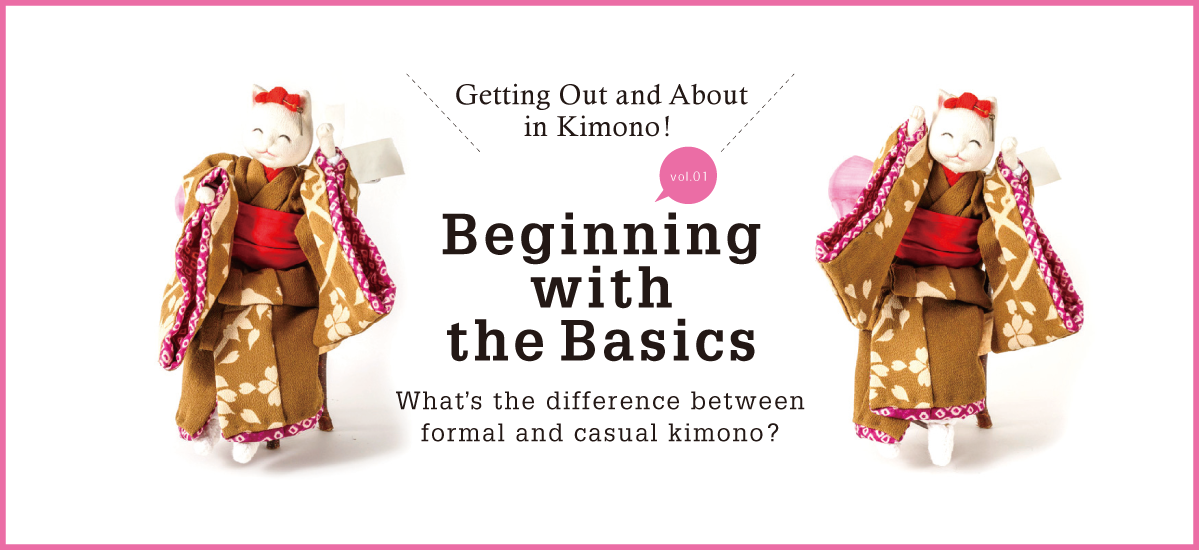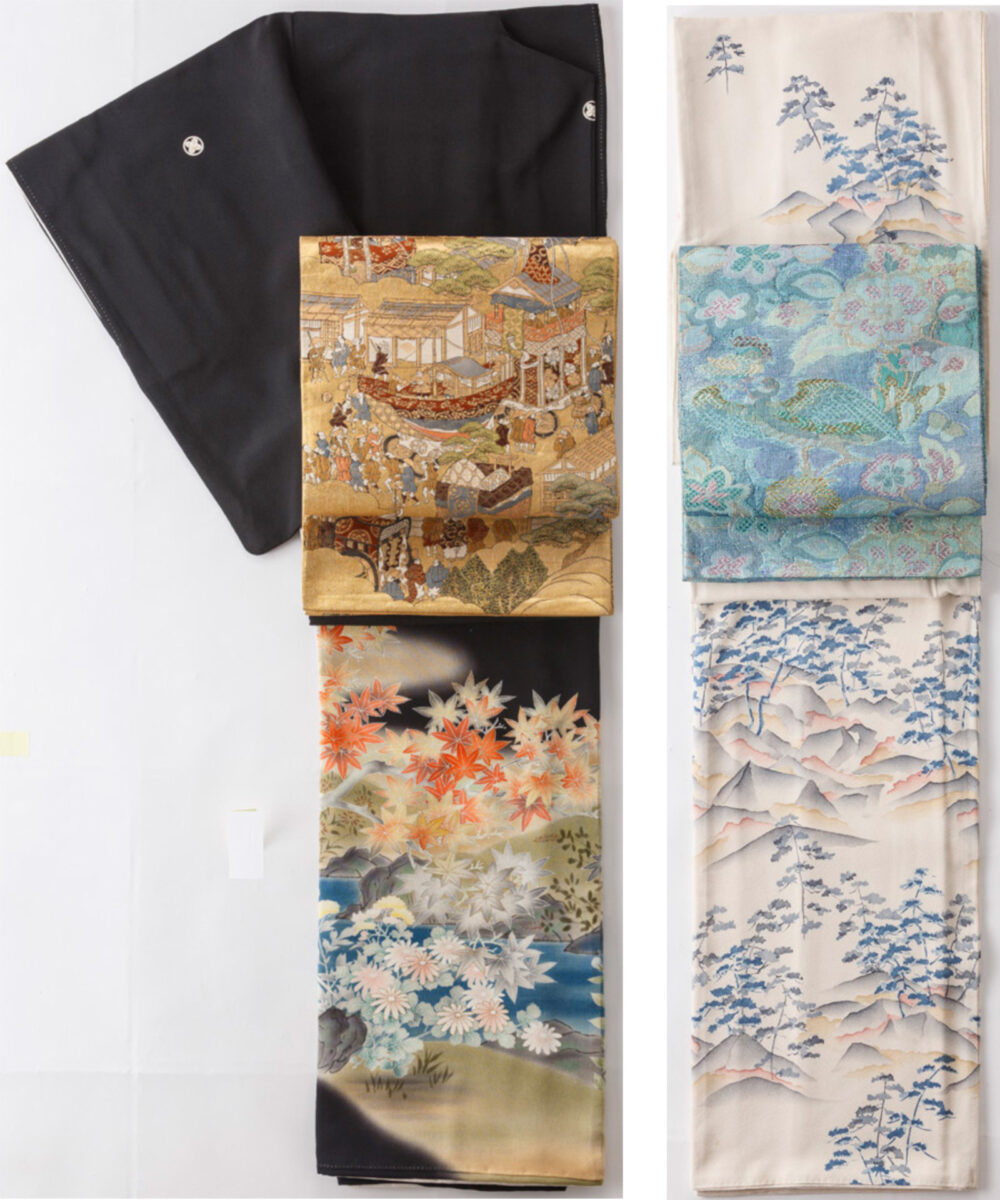

How many of us have kimono that we’d love to wear but never do? Perhaps it’s hard to know where to begin, or what type of kimono is suitable for which occasion. Sure, there are rules and conventions around wearing kimono, but that’s no different from the rules around wearing Western-style clothing – so don’t let that hold you back! This series explores the principles underpinning kimono culture, to help you find your own kimono fashion style.
Let’s look at some of the basic points to keep in mind when selecting kimono to suit the occasion.
Text : 湊屋一子 Ichiko Minatoya / English Version : Judy Evans
Begin by Considering the Occasion
The rules around wearing kimono depend on the occasion, the place and the wearer’s social position – which seems to scare a lot of people away right from the start! However, if you bear in mind that there are similar factors to consider with Western-style clothing, it’s surprisingly straightforward. After all, you wouldn’t wear an evening gown and tiara to your kid’s football match (but if you do, then you go, girl!), or jeans and a sweatshirt to a red carpet gala. So with these distinctions in mind, let’s take a look at some different types of kimono.
Formal Occasions Call for Formal Kimono
One of the most formal events you’re likely to attend in Japan is a lavish wedding reception in the banquet hall of a prestigious hotel, if you’re lucky enough to be invited to one. If you decide to wear kimono, the type of kimono you choose to will depend on your age, your relationship to the bride and groom, and your social standing relative to the bride and groom.
The matchmaker, the bride and groom’s parents, and any married sisters will wear tomesode kimono, bearing the family crest. This can be said to symbolise the joining together of two families.
Regular guests will wear a type of formal kimono known as homon-gi, in auspicious colours or patterns. Homon-gi come in various colours and patterns, and can be worn to a wide range of public events, from formal weddings to parties, arts and cultural events, and dinners at posh hotels.
Being labour-intensive to make, homon-gi can be fairly pricey. A slightly more simplified version, which looks like homon-gi at first glance, is a type of kimono called tsuke-sage. Strictly speaking, a tsuke-sage kimono has a lower status than homon-gi, but if the colour and pattern are chosen carefully, they can be worn to the same types of events as homon-gi.
Tomesode – The Evening Gown of the Kimono World
Tomesode are the most formal type of kimono, worn by married women. The upper half of the garment is generally black and features five small kamon (family crests), two on the front and three on the back. The pattern on the lower half creates a continuous picture, extending uninterrupted right around the garment. All kimono are made with an extended sleeve that hangs below the arm (seen when the arm is held away from the body). Unlike the long, flowing sleeves of the furisode kimono (formal kimono for young, unmarried women), this part of the sleeve is shortened on the tomesode, which signals that the wearer is married (or of a certain age). Tomesode sometimes come with background colours other than black, and these are known as iro-tomesode. To relate the tomesode to western-style wear, the tomesode is the formal evening gown of the kimono world.
Hōmon-gi – The Cocktail Dress Equivalent
If you’re an ordinary guest at a lavish wedding reception in a prestigious hotel, the hōmon-gi is the kimono for you. It can also be worn on fancy occasions such as parties, with the degree of formality of the garment depending on the fabric and pattern. Hōmon-gi are patterned on both the upper and lower part of the garment. The panels of fabric are pieced together so that the picture depicted continues uninterrupted from the front to the back and from the collar to the body of the garment. This is the cocktail dress of the kimono world.

Casual Kimono for More Relaxed Occasions
The typical casual kimono are the komon and the tsumugi kimono. Komon means “small pattern”, which describes a busy and detailed pattern over the entire fabric of the kimono. Unlike the more pricey tomesode and homon-gi, the pattern on the komon kimono does not flow in a continuous sweep around the garment. Depending on the fabric, as well as the colours and patterns, komon kimono can be suitable for occasions like parties or wedding receptions in restaurants, or even just for getting out and about in the neighbourhood.
Another casual kimono is the tsumugi. Tsumugi is the name of the fabric used for these kimono. With tsumugi, the patterns, which tend to feature stripes and plaids, are woven into the fabric using different coloured threads. In contrast, the patterns on tomesode, homon-gi and komon, are printed, painted or dyed onto the fabric after it has been woven. In the past, tsumugi was woven from a coarse silk thread spun from the left-over parts of silk cocoons. As such, tsumugi can only be considered as casual, everyday wear. This is a durable fabric that’s easy to wear and often comes in darker colours that don’t show stains. Tsumugi has recently become popular with women looking for chic kimono to wear as everyday fashion.
Komon
Komon can be styled for special occasions or as everyday wear, depending on the fabric, the colour, and the size and type of pattern. The pattern on a komon kimono is smaller than that on tomesode orhomon-gi. Some komon have the same pattern all over, while others have large areas of plain fabric with the pattern scattered here and there. These are called tobi-gara komon. Komon are the smart day dress or chinos and blazer of the kimono world.
Tsumugi
Tsumugi fabric was originally woven to make everyday garment and workwear. These days, tsumugi kimono can be considered suitable for the same purposes. However, some traditionally woven tsumugi fabric has been designated as an intangible cultural heritage and there are few weavers left. Accordingly, traditional hand-woven tsumugi, as well as kimono made by famous artists, can command astonishingly high prices, up to several million yen. But, and regardless of how much you might have paid for it, when it comes to tsumugi, think denim. This is the jeans and plain shirt of the kimono world.









